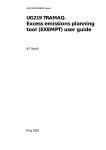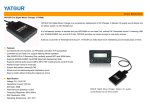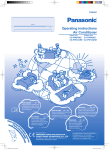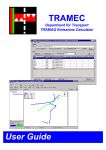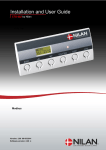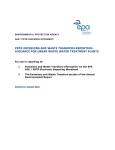Download Cold Start Advanced -user guide - Department for Environment
Transcript
Cold Start Advanced -user guide Work commisioned by UK Department for Environment, Food & Rural Affairs (Defra) ED 05450-304 Issue Number 1 December 2008 Title Cold Start Advanced - user guide Customer Defra Customer reference NAEI Extension 28 Deliverable Confidentiality, copyright and reproduction Copyright AEA Technology plc All rights reserved. Enquiries about copyright and reproduction should be addressed to the Commercial Manager, AEA Technology plc. File reference Reference number ED05450-304- CSA_UM_Issue 1 AEA Energy & Environment The Gemini Building Fermi Avenue Harwell International Business Centre Didcot OX11 0QR t: 0870 190 6439 [email protected] AEA Energy & Environment is a business name of AEA Technology plc AEA Energy & Environment is certificated to ISO9001 and ISO14001 Author Name Approved by Name Allan Smith, Yongfu Xu, John Norris, Agnieszka Griffin and Clare Allen Signature Date rd 3 December 2008 Cold Start Advanced Model - user guide Issue 1 AEA Energy & Environment iii Cold Start Advanced Model - user guide Issue 1 Table of contents 1 Introduction ...................................................................................................... 3 2 Loading the model ........................................................................................... 4 3 Using the model ............................................................................................... 4 3.1 3.2 3.3 4 3.1.1 Help ........................................................................................................................ 6 3.1.2 Quit, Return, Print ................................................................................................... 7 Input data ............................................................................................................................ 7 3.2.1 Input fields .............................................................................................................. 8 3.2.2 Vehicle parc definition .......................................................................................... 10 Outputs.............................................................................................................................. 10 3.3.1 Excess emission rates (Stage 3 driving) .............................................................. 11 3.3.2 Total excess emissions ........................................................................................ 11 3.3.3 Detailed results of the excess emissions ............................................................. 12 3.3.4 Session Report ..................................................................................................... 16 Scenarios ........................................................................................................ 18 4.1 4.2 AEA Main menu .......................................................................................................................... 5 Excess emissions as a function of distance from a car park ............................................ 18 4.1.1 Assessment for fully warmed up vehicles parking................................................ 18 4.1.2 Assessment for non-fully warmed up vehicles parking ........................................ 18 4.1.3 Other parking schemes ........................................................................................ 19 Excess emissions as a function of distance or time ......................................................... 19 1 Cold Start Advanced Model - user guide Issue 1 2 AEA Cold Start Advanced Model - user guide Issue 1 1 Introduction Modelling the emissions from vehicles is becoming an increasingly important activity in planning the environmental impact of future urban developments. This is largely done using emissions factors for vehicles which give their level of emission when being driven at their normal operating temperatures. However, in urban environments vehicles are usually started under engine conditions that are different to the hot operating conditions. The emissions from these vehicles can be very different to those calculated using the basic emission factors. This model seeks to address this issue and calculates the extra emissions that are produced when vehicles start from more realistic starting conditions. The results from this model may be used in conjunction with results from a traffic-based emissions model that calculates mass emissions on a road network from vehicles with their engines at normal operating temperature. These may come from models combining traffic based emission factors in g/km, (available from the National Atmospheric Emissions Inventory, http://www.aeat.co.uk/netcen/airqual/index.html, and the national emission factor database) with vehicle kilometres travelled on the road network. Alternatively they may come from other air quality and emission estimation procedures, for example the Highways Agency DMRB procedure “Design Manual Roads and Bridges, Volume 11, Section 3, Environmental Assessment Techniques: Part 1 Air Quality, May 2007”, where the user inputs traffic flows on specified road links to calculate emissions and air concentrations near the road side. The user can then add the impact of excess emissions from starting vehicles in an area to the hot exhaust emissions calculated. This might be useful for a scheme appraisal, for example a car-park or out-of-town shopping complex where many cars will starting their journeys with cold engines. The excess emissions calculated by the model are based on two series of measurements which encompass vehicles of different age ranges (year of manufacture of pre- and post-2000), diesel and petrol fuelled, and a range of engine sizes. The results from the model are weighted according to the proportions of the sampled car types in the national fleet in 2006, not in terms of the model types, but in terms of fuel type (petrol and diesel) and engine capacity. Options exist to alter this mix, either to reflect the vehicle parc composition between 2002 and 2006, or to use DfT fleet projection data for years 2007 to 2020. Alternatively, a user defined mix can be input. Note that no account is taken of excess emissions from non-catalyst gasoline engines. (In the 2006 petrol car vehicle parc, non-catalyst gasoline vehicles made up only 2.0% of the total number of vehicle-km driven, and this is predicted to fall to around 0.1% by 2010.) By assuming all gasoline vehicles have catalysts, the model slightly overestimates the total excess emissions - the overestimate decreasing as the number of non-catalyst vehicles decreases in future years. It should also be noted that this revised model updates the previous version of the model, EXEMPT, where only vehicles meeting the Euro 2 emissions standard were included. Changes in emissions standards have led to large reductions in excess emissions cold starting between Euro 2 and Euro 4 vehicles. Consequently, excess emissions from cold starting are much less that even 5 years ago, and scope for further reductions are more limited. Therefore it is anticipated that this model can be used as a “worst case scenario” for future years. The equations used to model the excess emissions were determined from experimental data as part of a UK DETR (previous name for DfT) funded project. The summary report of the project has the following reference: DCW Blaikley, AP smith, EA Feest and AH Reading, UG219 TRAMAQ- Cold start emissions. Summary report. AEA Technology report no. AEAT/ENV/R/0638 (May 2001), which can be obtained electronically from http://www.aeat.co.uk/netcen/airqual/research reports. AEA 3 Cold Start Advanced Model - user guide Issue 1 2 Loading the model The model has been incorporated into a Microsoft Excel spreadsheet. The user uses a mouse to click on menu options that run macros to enable access to the different areas of the model. The calculations are hidden from the user and occur instantly when any user input parameter has been changed. The user should either double click on the file name Cold_Start_Advanced(v1.0).XLS within Windows explorer, or open the file from within Excel. The file is a Microsoft Excel 2000 workbook. The user will be prompted by Excel to enable the macros. Click on the “Enable Macros” button. On opening the spreadsheet the appearance of Excel will be changed by macros within the spreadsheet, removing scroll bars, formula bars, etc. The workbook is protected from being accidentally corrupted by a set of passwords. Occasionally, and with some versions of Excel a password prompt appears. If this happens the user should click on the “Cancel” button each time, to close this window. The model has been tested using PCs running: Operating system Microsoft Windows XP Professional Microsoft Windows XP Professional Microsoft Windows XP Professional Microsoft Windows Vista Excel version Excel 2000 Excel 2002 Excel 2003 Excel 2007 and found to operate correctly for each configuration. 4 AEA Cold Start Advanced Model - user guide Issue 1 3 Using the model This section will describe the user operation of the model and the results given. 3.1 Main menu The opening sheet of the model (the main menu) has three options, as per the picture below. Selecting any of the options will either take the user to a new sheet, or quit from the model. Figure 3-1 Main Menu Sheet AEA 5 Cold Start Advanced Model - user guide Issue 1 3.1.1 Help Selecting the option Help loads a screen that gives a brief description of the model and its purpose. Figure 3-2 Help screen Selecting the option Instructions in the Help option loads a brief summary of the steps required to run the ‘Excess emission modelling’ program. 6 AEA Cold Start Advanced Model - user guide Issue 1 Figure 3-3 Instructions in the help menu 3.1.2 Quit, Return, Print Selecting the Quit option from the main menu will close down the model and restore Excel settings to include the formula bar, scroll bars, etc. The user will be prompted to ensure that they want to quit. The user returns to the main screen by clicking on the return, main menu buttons on the sheet. The Print option enables the user to print the results of each chosen output option. 3.2 Input data Selecting the Input Data & Results button accesses the sheet in which the user enters the information relevant for the simulation to be performed. The total excess emissions of each pollutant integrated over all vehicles and all three stages are displayed. The simulation is split into three stages: 1. Driving – initial driving assuming cold start 2. Parking – the time of cooling down the engine 3. Driving – driving following the initial driving and parking, with the engine in a semi-warm initial state. AEA 7 Cold Start Advanced Model - user guide Issue 1 Figure 3-4 Input Data and Results screen 3.2.1 Input fields Stage 1 driving – requires four inputs. In the total number of vehicles field the user enters the number of vehicles taking part in the modelled simulation. This figure applies also to the Stage 2 (Parking) and Stage 3 (Driving) portions of the input, too. The ambient temperature input cell gives the user the option to: Either 1. enter a temperature ranging from -10°C to 30°C or 2. choose the region in the UK by entering the regional code to select the annual mean temperature of the region as the ambient temperature. The regional codes are presented in the Table 3-1 8 AEA Cold Start Advanced Model - user guide Issue 1 Table 3-1 The regional codes Regional code Region in the UK 100 London and South England 200 Midlands 300 Northern England 400 Scotland 500 Wales 600 Northern Ireland Vehicle start oil temperature – the start oil temperature must not be less than the ambient temperature, and must be less than 120°C Driving distance – the initial driving distance should reflect/describe the distance to the assumed first stop/parking. If the user is interested only in a single journey, then it is recommended that this distance be set to 0.001 km (i.e. 1 m) which effectively removes the first two stages from the calculation. Stage 2 parking The stage 2 parking models the cool down of the vehicle after the initial driving stage. Two inputs are required: Ambient Temperature – enter an ambient temperature between –10°C to 30°C Parking Time - enter the time the vehicle has its engine switched off, in minutes Stage 3 driving The final driving stage requires two inputs Ambient Temperature – enter the ambient temperature, which must be between –10°C to 30°C Driving Distance – enter the driving distance in kilometres from parking to the assumed destination. The vehicle temperature at the start of stage 3 is calculated by the model from Stage 1 driving and Stage 2, parking (i.e. cooling) stages. Note that the model can be used to calculate the emissions from a single stage by setting the time of 1 Stage 2 to zero and the distance of Stage 1 to 0.001 km . In principal, setting the time of Stage 2 to zero and the distance of Stage 3 to 0.001 km might be assumed to be equivalent. However, as will be seen in Section 3.3.1, the Excess Emission Rates results screen is calculated for the Stage 3 driving only, and this alternative would not generate these results. 1 Because of some logarithmic and reciprocal mathematical relationships used to calculate the excess emissions, a value of 0.0 km would generate an error, and is therefore not permitted. AEA 9 Cold Start Advanced Model - user guide Issue 1 3.2.2 Vehicle parc definition By selecting the Vehicle parc option the user can alter the distribution of vehicle types used in the calculation of the excess emissions. Passenger cars are grouped into 5 different categories, comprising diesel cars with two different engine sizes, and petrol cars with three different engine 2 sizes . Vehicles within each category are divided into two emission standards groups, Euro 1 & 2, or Euro 3 & 4. The percentages of each type should be set to represent the overall vehicle population distribution to be modelled. The grand total percentage should be exactly 100%. If this is not the case an error warning will be printed in other areas of the model. Figure 3-5 Shows the vehicle parc definition screen The Predicted UK Vehicle Parc for years between 2002 - 2020 option allows the automatic setting the percentage of vehicles by vehicle category for a chosen year. These percentages are based on the national fleet in terms of fuel type (petrol and diesel), engine capacity split and vehicle emission standards as determined by DfT data for 2006 and earlier, and DfT projections for post-2006. No anticipation is made regarding the cold start performance of Euro 5 and 6 vehicles (which will be on the road in the future). Their performance is assumed to be the same as that for the Euro 3 and 4 vehicles already within the model. The total percentage of vehicle parc can be set manually and saved as a default vehicle parc by using the option save this as the default vehicle parc. The option select your default vehicle parc enable the user to use the saved default vehicle parc. 3.3 Outputs This section of the model has changed quite significantly relative to the original EXEMPT model. There are four output options: • Excess emission rates (Stage 3 driving) • Total excess emissions • Detailed results, and 2 These passenger car categories have been selected to coicide with the categories for which hot emission factors are provided in the NAEI and EMEP CORINAIR emissions guidebook. 10 AEA Cold Start Advanced Model - user guide Issue 1 • 3.3.1 Session report. Excess emission rates (Stage 3 driving) From the screen entitled Input data and results the user can access Excess Emission Rates 3 (Stage 3 driving) which gives the excess emission rates for each pollutant, in units of g/m for the number of vehicles and the vehicle parc selected. Emission rates are given for a range of distances from 0 – 10 km from where the vehicles start their engines and the total excess emissions from driving 10 km can be found at the bottom of the table, for each pollutant. (These emission rates data are independent of the driving distance input for Stage 3 - Driving.) Figure 3-6 Excess emission rates The excess emission rates for each pollutant can be seen graphically by selecting the appropriate button showing two arrows >> placed under the column of numerical data. 3.3.2 Total excess emissions Selecting the option Total excess emissions brings up the screen entitled Excess Emissions of the Specified Trip where sum of the excess emissions of the pollutants from both the Stage 1 driving, and the Stage 3 driving, following the parking profile defined in Stage 2, are given. (This is the principal output screen that was available from the previous version of this model, EXEMPT.) The column headed ‘per trip’ gives the excess emissions for each pollutant from the traffic specified by the input data. 3 Note the units – the excess emissions are given in grams per metre rather than the more usual unit for hot emissions of grams per kilometre AEA 11 Cold Start Advanced Model - user guide Issue 1 The column headed ‘per annum’ gives 365 times the “per trip” results (but in mass units of kg rather than g). This assumes that there is the same traffic each day as specified by the input data. Regional monthly temperatures are used in the calculation when a regional code is given. Figure 3-7 Excess emissions of the specified trip 3.3.3 Detailed results of the excess emissions Selecting the Detailed Results button this will take you to the screen shown in Figure 3.8, which provides three options: • Detailed Results • Graphs Menu • Return Selecting the Detailed Results option will take the user to the screen shown in Figure 3-9. This presents detailed results, on a stage-by-stage basis, for each individual vehicle type. For the two driving cycles, the excess emission per vehicle for each vehicle type are listed, together with the total when integrated over all vehicles. 12 AEA Cold Start Advanced Model - user guide Issue 1 Figure 3-8 Detailed results of the excess emissions Figure 3-9 Detailed results, on a stage-by-stage basis, for each individual vehicle type AEA 13 Cold Start Advanced Model - user guide Issue 1 The results in Figure 3-9 are calculated using the data listed under input data and vehicle parc described earlier. Graphs menu Selecting the option Graphs menu accesses the menu screen shown in Figure 3.10. The five pollutant chart options generate the appropriate histogram of total excess emission, summed over all stages and every vehicle within a vehicle category, for the three stages as defined in the Input Data input screen. An example of one such plot, for NOx excess emission, is given in Figure 3-11 for the data listed in Figure 3-9. Figure 3-10 Graphical display of estimated excess emissions 14 AEA Cold Start Advanced Model - user guide Issue 1 Figure 3-11 Example of the graph AEA 15 Cold Start Advanced Model - user guide Issue 1 This is useful for identifying the principal groups of vehicles responsible for generating the excess emissions. For example, from Figure 3-11 it is seen that the small Euro 3 & 4 gasoline cars give the highest contribution, whilst Euro 1 & 2, and all 1.4 to 2.0 litre passenger cars contribute around 60% each. Modern (Euro 3 and 4) diesel cars tend to generate a reduction in NOX emissions relative to their NOx emissions when at their normal operating temperature. 3.3.4 Session Report Selecting the option Session Report provides the user with a list of the input data, vehicle parc used, and all the results, including ten graphs. The first portion of this, as it appears on the user’s screen before scrolling down is shown in Figure 3-12. Figure 3-12 Session report 16 AEA Cold Start Advanced Model - user guide Issue 1 AEA 17 Cold Start Advanced Model - user guide Issue 1 4 4.1 Scenarios Excess emissions as a function of distance from a car park The “Cold start – Advanced” model can be used to calculate the distribution of excess emissions as a function of distance from a car park. These arise because vehicles’ engine temperatures will have cooled during the parking time. 4.1.1 Assessment for fully warmed up vehicles parking For example, let us assume that all vehicles arrive in the car park with their engines hot, producing no excess emission in the surrounding area on the way to the car park. If the car park was attached to a sports complex, we might assign a parking time of 100 minutes. This time would vary depending on the car park application. We will also assume a total of 1000 parked vehicles during a cold winter’s day with an ambient temperature of 0°C. In order to ensure that the vehicles arrive hot, we set the stage 1 distance to a high value, e.g. 10 km, with a start temperature of 50°C and ambient temperature of 0°C. We set the time for parking in Stage 2 as 100 minutes and the ambient temperature is set to 0°C. For Stage 3 we also set the ambient temperature to 0°C. The distance for the stage 3 driving is not important to the results given in the “Excess Emissions Rates (Stage 3 Driving)” output screen, but could be set to 10 km. The “Excess Emissions Rates (Stage 3 Driving)” gives the excess emission rates, in units of grams per metre (rather than units of g/km which are usually used for hot emission rates) as a function of distance from the car park, in ten distance ranges (again expressed in metres) up to 10 km from the point of start the vehicles’ engines. These rates are independent of the Stage 3 Driving Distance entered. The initial stage (stage 1 driving) will produce some excess emissions that are added to the excess emissions from driving the 10 km away from the car park. This can be calculated and is the difference between the “Excess Emissions of the Specified Trip” output value, and the total excess emissions over 10 km from Stage 3 driving values provided on the “Excess Emissions Rates” output screen. 4.1.2 Assessment for non-fully warmed up vehicles parking The excess emissions generated by vehicles arriving at the car park whose engines are not at their normal operating temperature can be found in the same way. For example, for vehicles travelling 2 km to the car park, we set the Stage 1 Driving Distance to 2 km, with an engine start temperature of 0°C and the ambient temperature also as 0°C. When the vehicles arrive at the car park their engine temperatures will be below their normal operating temperature, and they will cool down from this lower temperature. Consequently, when restarted their engine temperature will be lower, and the excess emissions rate will be higher, than was the case for the scenario described in Section 4.1.1. In addition, because the vehicles did not arrive with a fully warmed engine, the excess emissions generated by vehicles travelling to the car park ought to be included in the calculation. The approach recommended to quantify this is to create a scenario such that at the start of Stage 3 Driving, the vehicle is essentially cold, e.g. through having the Stage 1 driving distance 0.001 m, and the Parking time 120 minutes. Then the “Excess Emissions Rates (Stage 3 Driving)” gives the excess emission rates as a function of distance driven. If it is adjudged that 10% of the cars reaching the car park have travelled around 1 km, 30% 1 – 2 km etc, and it is the excess emissions on an access road into the 18 AEA Cold Start Advanced Model - user guide Issue 1 car park, and within the car park, that are of interest, the “Excess Emissions Rates” screen gives these excess emission rates (in units of grams per metre) for the appropriate distance range. 4.1.3 Other parking schemes The model can simulate many different car parking arrangements. For example, the parking time might be different if the car park is for a shopping centre (a distribution of parking times could be used). 4.2 Excess emissions as a function of distance or time The revised “Cold Start – Advanced” model, unlike its predecessor, EXEMPT, does give information about the spatial distribution of the excess emissions produced from a specified set of conditions, through the “Excess Emissions Rates” output screen. This removes the need to undertake some of the more convoluted calculations described in the previous user guide. In addition, the distance ranges given in the “Excess Emissions Rates” output screen can be converted into time ranges, see the table below. This conversion is based on the 18.4 km/hr average speed of the driving cycle used to quantify the excess emissions (the ECE component of the NEDC). Distance travelled Time taken to travel this distance at 18.4 kph 0m 0s 100 m 19.5 s 200 m 300 m 400 m 500 m 1,000 m (1 km) 2,000 m (2 km) 4,000 m (4 km) 6,000 m (6 km) 8,000 m (9 km) 10,000 m (10 km) 39 s 58.5 s 78 s 97.5 s 3.25 min 6.5 min 13.0 min 19.5min 26.0 min 32.5 min This can be used, in conjunction with the speed related hot emission factors for vehicles, to assess the excess emissions generated, or saved, by altering journey times. For example, if the rephrasing of traffic lights were predicted to cause a reduction in journey times of 20% for the first 500 m driving away from a car park, then time taken would become 78 seconds, rather than 97.5 seconds. In terms of distance, the excess emission rate for the first 19.5 seconds would now be that distributed over 125 m, rather than 100m. Consequently, the new emission rate would be 100/125 (i.e. 80%/100%) of that given in the “Excess Emissions Rates” output screen. For the given example, the total excess emissions over 500 m would become 100 x (sum of first 4 emission rates in the table). This will be greater than 80% of the original excess emissions because of the non-linearly reducing excess emissions with distance from the starting location or with time following engine start. AEA 19























